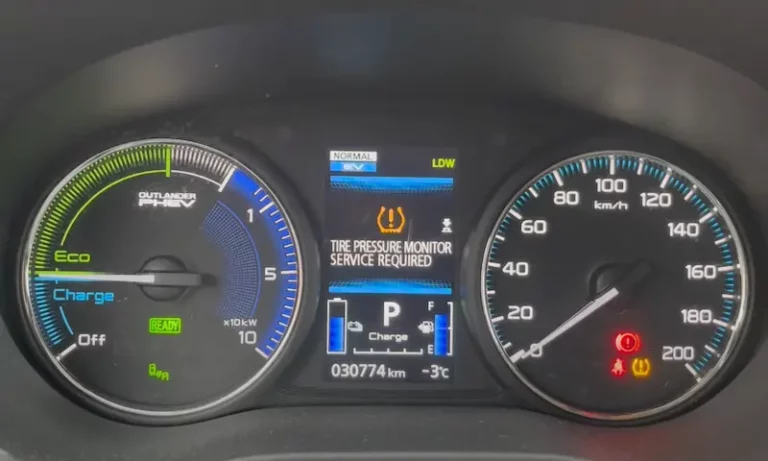If you’re driving a Mitsubishi Outlander and notice the TPMS Service Required message or Tire Pressure Monitor Service Required message, it’s time to pay attention to your vehicle’s tire pressure monitoring system. This alert means that the system, which tracks your tire pressure to ensure your driving safety, may need attention. Whether it’s a tire pressure check or a sensor reset, addressing this warning is crucial for maintaining your vehicle’s performance and your safety on the road.
Understanding the TPMS and its importance in your Mitsubishi Outlander ensures you’re always ready for the journey ahead. The system is designed to alert you if tire pressure is too low or high, which can lead to decreased fuel efficiency, poor handling, or even tire failure. So when the TPMS Service Required message pops up, it’s more than just a light; it’s a call to action to keep your Outlander in top condition.
Understanding TPMS in Mitsubishi Outlander
If you own a Mitsubishi Outlander, it’s important to be familiar with the Tire Pressure Monitoring System (TPMS) as it plays a vital role in both your vehicle performance and safety.
Basics of Tire Pressure Monitoring System
TPMS in your Mitsubishi Outlander is an electronic system designed to monitor the air pressure inside your pneumatic tires. It alerts you if the pressure falls below or rises above the recommended levels. The importance of maintaining proper tire pressure cannot be overstated; it ensures optimal tire performance, fuel efficiency, and reduces the risk of tire failure.
Components of Mitsubishi TPMS
The Mitsubishi Outlander’s TPMS mainly consists of sensors attached to your wheels. These sensors are responsible for sending real-time tire pressure information to the vehicle’s Electronic Control Unit (ECU). There are two types of TPMS sensors: OE (Original Equipment) sensors, which are installed by the manufacturer, and aftermarket sensors that can be used as replacements if necessary. These sensors play a crucial role in maintaining the integrity of your TPMS and, consequentially, your vehicle’s safety on the road.
Interpreting TPMS Warnings
TPMS, or Tire Pressure Monitoring System, is crucial for your driving safety, alerting you when tire pressure is low or if there’s a system malfunction. This brief guide will help you understand what your Outlander’s TPMS warnings mean and how to respond to them.
Meaning of TPMS Service Required Message
The TPMS Service Required message on your Mitsubishi Outlander is more than a mere reminder; it signifies a potential issue with the tire pressure monitoring system itself. While it could be triggered by a simple sensor battery failure, it might also indicate a malfunction within the monitoring system. This message differs from the standard TPMS warning light, which signals that one or more of your tires are significantly under-inflated.
Understanding TPMS Warning Lights and Indicators
- Solid TPMS Warning Light: A non-flashing, illuminated warning light is a clear indicator of low tire pressure. You should check and adjust your tire pressure as soon as safely possible to the recommended value for your vehicle.
- Flashing TPMS Warning Light: If the light flashes for approximately one minute upon starting your vehicle before staying solid, it suggests that there may be a fault with the TPMS system. This could be due to a sensor issue or a communication error between the vehicle’s computer and the TPMS.
Should you encounter either the service message or a flashing indicator, it’s advisable to schedule a visit to a qualified technician who can conduct a thorough diagnostic check of the TPMS and address any issues. Maintaining optimal tire pressure with a fully functional TPMS is key to your Mitsubishi Outlander’s performance and your safety on the road.
Routine TPMS Maintenance
Maintaining your Mitsubishi Outlander’s Tire Pressure Monitoring System (TPMS) can help prevent premature tire wear and ensure optimal fuel efficiency. Regular checks and service will keep the system functioning correctly.
Checking Tire Pressure Regularly
Checking your tire pressure should be a part of your routine vehicle maintenance. Using a reliable tire pressure gauge, ensure each tire is inflated to the recommended pressure level, typically found on a sticker inside the driver’s door jamb or in your owner’s manual. Inconsistent tire pressure can lead to premature tire wear and affect your car’s handling.
Scheduled TPMS Sensor Service
Over time, TPMS sensors may require service or replacement to maintain their accuracy. It’s important that these sensors are checked regularly as part of the vehicle’s scheduled service. This often involves:
- Battery Check: TPMS sensors are powered by batteries, and these may need replacing after several years.
- Sensor Inspection: Checking for damage to sensors from road debris or tire changes.
Ensure that the service of your TPMS sensors is a part of your routine vehicle maintenance to keep the system providing accurate readings. A well-maintained TPMS will alert you to low tire pressure, helping to prevent tire wear and keep your vehicle running smoothly.
Resetting the TPMS
When you see the “TPMS Service Required” message on your Mitsubishi Outlander, it indicates that your Tire Pressure Monitoring System (TPMS) needs attention. You might need to reset the TPMS after a tire rotation, inflation adjustments, or replacement of sensors. Doing so ensures correct readings and helps maintain proper tire pressure, which is crucial for safe driving and tire longevity.
Step-by-Step TPMS Reset Process
To successfully reset your Mitsubishi Outlander’s TPMS, follow these steps:
- Ensure your vehicle is in a stationary state with the engine turned off.
- Turn the ignition to the “ON” position but do not start the engine.
- Locate the TPMS Reset Button. It’s typically located on the dash menu.
- Press and hold the TPMS Reset Button until the TPMS warning light blinks several times.
- Release the button and start the engine. Let it run for about 20 minutes; this allows the system to perform a relearn procedure.
The above steps can vary depending on the model year of your Outlander, so check the owner’s manual for specific instructions related to your vehicle.
Common TPMS Reset Issues and Solutions
Occasionally, you may run into issues while resetting your TPMS. Here’s how to address some common problems:
- TPMS Warning Light Remains On: If the light doesn’t blink during resetting or remains on after completion, ensure all tires, including the spare, are inflated to the correct pressure and retry the process.
- Reset Button Doesn’t Work: If pressing the reset button doesn’t appear to do anything, verify that your Outlander is in the correct mode, with the ignition on and the engine off. If the issue persists, there may be a malfunction that requires professional diagnostics.
- Sensors Not Relearning: After tire replacement or rotation, sensors may need time to relearn their positions. Drive your vehicle for at least 20 minutes at a speed of 15 mph or more to give the sensors time to complete the relearning process, as detailed in these instructions for the 2022 Mitsubishi Outlander Tire Pressure Sensor.
In case these solutions don’t resolve your TPMS issues, consider consulting a certified mechanic or your local dealership for support. Properly functioning TPMS sensors are integral to your vehicle’s performance and safety.
Upcoming Developments in TPMS Technology
As technology evolves, so does the Tire Pressure Monitoring System (TPMS) in vehicles like your Mitsubishi Outlander. The future promises more accurate systems and intuitive displays to ensure your driving safety and tire efficiency.
Future of Mitsubishi’s TPMS
Your Mitsubishi, known for models such as the Outlander and Lancer, is set to integrate Direct TPMS systems more deeply into vehicle functionality. This means you can expect real-time tire pressure monitoring with increased precision. The recommended tire pressure for your specific model will be easier to maintain with advancements directly impacting both Asian and domestic markets. Technologies such as improved signal processing and diagnostic features are in development, aiming to provide you with a seamless and user-friendly TPMS experience.
Advancements in TPMS Sensors and Displays
Expect to see TPMS sensors become more sophisticated. They’re anticipated to be smaller, longer-lasting, and capable of measuring additional tire parameters beyond just pressure. For your Mitsubishi’s dashboard, enhancements in the Cluster Display will likely present tire pressure information in a more intuitive format. This might include color-coded alerts or graphical representations to help you quickly identify and resolve tire pressure discrepancies. These improvements aim to make maintaining proper tire pressure hassle-free, ensuring you always drive with optimal tire efficiency and safety.
Conclusion
Encountering the TPMS Service Required message Tire Pressure Monitor Service Required message on your Mitsubishi Outlander can be perplexing, especially if your tires seem fine. Typically, the message indicates a discrepancy in tire pressures or a potential malfunction in the monitoring system. Before you head out for a service, check your tire pressures and adjust them to the manufacturer’s recommended levels. If the message persists, it might be due to a malfunctioning TPMS sensor or a need for sensor reprogramming, as noted in the Mitsubishi Motors Service Information Retrieval.
It’s valuable to take this warning seriously, as tire pressure is crucial for your vehicle’s handling, fuel efficiency, and safety. If your own troubleshooting doesn’t clear the message, your next step is to consult with a professional. Many tire or automotive repair shops are equipped to handle TPMS issues and can offer insight or perform necessary repairs.
For consistent TPM system performance, regular maintenance checks are advisable. Keeping up with periodic reviews and responding promptly to TPMS alerts can help ensure your Outlander remains safe and roadworthy.















